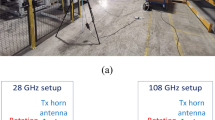Abstract
The results of channel soundings taken on a selection of six different industrial sites are presented. These results focus on the RMS delay spreads calculated from the channel soundings and the distribution of these results for each site. The distribution of RMS delay spread values is analysed and forms the basis of a statistical description of the multipath propagation on the tested sites. In particular the distribution is used to define the expected propagation delay across the site. The relation between the RMS delay spread and the irreducible-BER is discussed and this is used to link the distribution of RMS delay spread values to bit error rate performance on industrial sites. It is seen that the environment surrounding sites is significant.
Similar content being viewed by others
References
H.L. Bertoni, S.-C. Kim and M. Stern, “Pulse propagation characteristics at 2.4 GHz inside buildings”, IEEE transactions on Vehicular Technology, Vol. 45, No. 3, August 1996
H. Hashemi, “The indoor radio propagation channel”, Proceedings of the IEEE, Vol. 81, No. 7, pp. 943–968, July 1993.
T.S. Rappaport. Wireless Communications, Principles and Practice, Prentice Hall PTR, 1 edn., 1996, ISBN0133755363.
E.B. Bryant and A.H. Kemp, “UHF channel impulse response measurements in previously uncharacterised industrial environments,” in ECWT2000, Paris, France, European conference on Wireless Technology, ISBN: 0862132177, pp. 281–284, 2000.
J.C-I. Chuang, “The effects of time delay spread on portable radio communications channels with digital modulation,” IEEE Journal on Selected Areas in Communications, Vol. SAC-5, No. 5, June 1987.
J. Bach Anderson, T.S. Rappaport and S. Yoshida, “Propagation measure ments and models for wireless communications channels,” IEEE Communications Magazine, pp. 42–49, January 1995.
I. Crohn, G. Schultes, R. Gahleitner and E. Bonek, “Irreducible error performance of a digital portable communication system in a controlled time-dispersion indoor channel,” IEEE Journal on Selected Areas in Communications, Vol. 11, No. 7, September 1993.
T.A. Wilkinson and S.K. Barton, “Receiver techniques for direct sequence spread spectrum ISM band radio LANs,” in ISSSTA94, Helsinki, Finland, pp. 376–380, 1994.
R. Walpole and R. Myers, Probability and Statistics for Engineers and Scientists, Macmillan, 5th edn., 1994.
A. Healey, C.H. Bianchi and K. Sivaprasad, Wideband outdoor channel sounding at 2.4 ghz,” in Proceedings of Conference on Antennas and Propagation for Wireless Communications, Waltham, MA, USA, pp. 95–98, November 2000.
Author information
Authors and Affiliations
Corresponding author
Additional information
Andrew H. Kemp Andrew was born in Portsmouth, UK in 1963. He received a BSc from the University of York in 1984 and PhD from the University of Hull in 1991. His doctoral studies investigated the use of complementary sequences in multi-functional architectures for use in CDMA systems. He spent several years working in Libya and South Africa assisting in seismic exploration and worked at the University of Bradford as a research assistant investigating the use of Blum, Blum and Shub sequences for cryptographically secure 3rd generation systems. More recently he helped develop wireless fieldbus systems for industrial sites and is now lecturing at the University of Leeds, UK in communications. Andrew has over 30 scientific journals and conference papers and a book chapter published. His research interests are in multipath propagation studies to assist system development and wireless broadband connection to computer networks incorporating quality of sevice provision.
Edmund B. Bryant Ed Bryant was born in Staffordshire, UK in 1967. After a state education he graduated from Leeds Polytechnic with a BEng in Communication Engineering in 1990. He received a NERC case award for a doctorate at the University of Sheffield in 1991, and achieved a PhD in 1995 entitled ‘Radio Tracking of Pinnipeds’. He was subsequently employed by the NERC Sea Mammal Research Unit as a Research Fellow investigating low power radio location systems. In 1997 he spent time in industry designing electronic warfare receivers until he returned to academia at the University of Leeds in 1998. His primary research interests were in channel sounder design and multipath radiowave propagation studies. He left the University of Leeds as a Senior Research Fellow in 2003 to run his own company developing GPS receivers for marine animal research.
Rights and permissions
About this article
Cite this article
Kemp, A.H., Bryant, E.B. Channel Sounding of Industrial Sites in the 2.4 GHz ISM band. Wireless Pers Commun 31, 235–248 (2004). https://doi.org/10.1007/s11277-004-4169-z
Issue Date:
DOI: https://doi.org/10.1007/s11277-004-4169-z




